
Oil Prices Slip — WTI at $63.11, Brent at $66.10 on Supply Pressure
Crude retreats as OPEC+ adds barrels, non-OPEC growth stays firm, and traders watch $62 WTI and $65 Brent for next support | That's TradingNEWS
Oil Market Snapshot: WTI (CL=F) at $63.11, Brent (BZ=F) at $66.10 as Futures Slide into Late Session
WTI Crude Sep ’25 is marked at $63.11, down $0.85 or 1.33%, while Brent is quoted at $66.10, lower by $0.53 or 0.80%. The Brent–WTI spread sits at $2.99, a narrow but intact premium that still reflects seaborne grade tightness versus inland U.S. barrels. The curve softness into the close underscores how supply additions and macro caution are overpowering pockets of risk-on sentiment. Liquidity is decent, but the intraday tone is heavy: every rally toward $63.80–$64.20 in WTI and $66.50–$66.80 in Brent is being sold, pushing settlement risks toward the day’s lows with discretionary CTA supply leaning short on weakness.
OPEC+ Throughput and the Compliance Math
Producer discipline is wobbling at the margin. Combined OPEC+ crude output increased by 335,000 bpd in July, shy of the 411,000 bpd hike eight producers had signaled, but still a net addition that leans bearish for flat price. Inside the bloc, OPEC-only production rose by 263,000 bpd, with Saudi Arabia responsible for a 170,000 bpd jump and the UAE adding 109,000 bpd. The Kingdom’s numbers carry a caveat: communication around “production” versus “supply to market” indicates some flows were diverted to storage, an accounting nuance that blunts immediate physical tightness but leaves a latent overhang if those stored barrels reappear on prompt cargo lists. With the alliance preparing a 547,000 bpd increase in September to complete rollbacks, the market is rightly stress-testing downside levels now rather than later.
Demand Trajectory: Near-Term Fragility, Medium-Term Resilience
On the demand side, the near-term tape is cautious, but the medium-term ledger has improved. OPEC’s latest tables lift 2026 global oil demand growth to 1.38 million bpd, citing better prospects across OECD America, OECD Europe, the Middle East, and Africa. For 2025, demand growth holds near 1.29 million bpd with Q4 consumption projected to touch the high 106 million bpd handle. Those are supportive foundations for 2026–2027 balances, yet they do little to offset the current week’s pressure from fresh supply plus macro data that keeps traders defensive into each CPI/PPI print.
Non‑OPEC+ Supply Leaders and the 2026 Pivot
Non‑OPEC+ liquids growth for this year is anchored by the U.S., Brazil, Canada, and Argentina, with the U.S. accounting for roughly 310,000 bpd of 2025’s increase. The baton passes in 2026: Brazil is projected to become the top non‑OPEC+ growth engine at about 160,000 bpd, ahead of the U.S. at roughly 130,000 bpd. That mix matters for quality and freight—Brazil’s offshore barrels compete directly in Atlantic Basin slates, pressuring Brent-linked differentials and, by extension, compressing the Brent–WTI spread when U.S. Gulf Coast arb windows are not wide open. Today’s $2.99 spread is consistent with that narrative: soft but not collapsed, leaving refiners little urgency to chase imports while U.S. inland barrels remain well supplied.
Macro and FX: Softer Inflation, Firm Dollar Bids on Event Risk
Headline U.S. CPI printed 0.2% m/m with the annual rate holding near 2.7%, while core firmed on the margin. Rate‑cut odds into September remain elevated, but the dollar has been stubbornly bid around the high‑90s on the DXY into data and policy headlines. For crude, that mix is a tax on price: easier policy expectations are not translating to weaker USD enough to lift commodities, and energy’s idiosyncratic supply story is dominating. With risk sentiment stabilizing around geopolitics and tariffs for now, oil is trading the balance sheet—barrels, not vibes.
Physical and Time‑Spread Signals: Overhang, Not Panic
Time spreads on both WTI and Brent have eased, consistent with a market digesting incremental OPEC+ supply and steady non‑OPEC+ growth. The prompt Brent structure is soft but not flipping dramatically into contango, which tells you this is cooling tightness rather than an outright glut. U.S. differentials are behaving like a market with enough barrels inland and at the Gulf; there’s no widespread sign of run‑cuts or acute prompt cargo distress, but bids lack urgency, which keeps rallies capped and pushes producers to lean on storage or roll hedges forward.
Technical Structure: Gravity Near $63 for WTI, $66 for Brent
Technically, WTI is testing a sticky band around $63.00 with intraday failures near $64.00. A decisive daily close below $63.00 opens a glidepath toward the low‑$62s where dip‑buyers have historically defended. Brent faces layered supply in the $66.50–$67.00 zone; repeated fades there keep the focus on $66.00 and then $65.40 as momentum checkpoints. The Brent–WTI spread at $2.99 is mid‑range; a slip toward $2.50 would imply U.S. balances loosening faster than seaborne, while a re‑widening toward $3.50 would suggest Atlantic Basin tightness returning—neither is confirmed today.
Positioning, Flows, and the Path into September
Systematic funds remain sensitive to downside break levels; a WTI daily settle sub‑$63.00 tends to invite incremental model selling. Refining margins are adequate but not spectacular, which limits runs from bailing out prompt barrels. On the producer side, OPEC+’s 547,000 bpd September boost sits like a calendar cliff—forward markets are discounting that risk now, flattening the upside unless a supply disruption or materially stronger demand surprise appears. With non‑OPEC+ growth re‑accelerating in Brazil next year and U.S. output still rising this year, discretionary length is skittish and quick to take profits.
Verdict on Crude: Hold with a Bearish Tilt Until WTI Reclaims $64.20 and Brent Clears $67.00
At WTI $63.11 and Brent $66.10, the risk/reward for fresh longs is poor without confirmation. For a tactical bullish pivot, WTI needs a daily close back above roughly $64.20 to neutralize momentum, and Brent must retake $67.00 with conviction to reset the ceiling. Until then, the tape favors sellers into strength with eyes on $62‑handle defenses in WTI and $65‑mid in Brent. Medium term, the 2026 demand uplift and manageable non‑OPEC+ growth argue against a deep breakdown, but the next 2–4 weeks are governed by the simple arithmetic of more barrels meeting cautious macro.
That's TradingNEWS
Read More
-
BITQ ETF Soars 66.55% as Bitcoin Blasts Past $124,000 — Crypto Equities Lead 2025 Rally
13.10.2025 · TradingNEWS ArchiveStocks
-
XRP ETFs XRPR, XRPI Slip as Ripple XRP-USD Holds $2.62 — SEC Fast-Track Could Ignite $20B
13.10.2025 · TradingNEWS ArchiveCrypto
-
Natural Gas Price Forecast - NG=F Steadies at $3.00 as U.S. Export Boom Tests Old Fields
13.10.2025 · TradingNEWS ArchiveCommodities
-
USD/JPY Price Forecast - Dollar to Yen Climbs to ¥152.28 as Japan’s Political Shakeup
13.10.2025 · TradingNEWS ArchiveForex



















